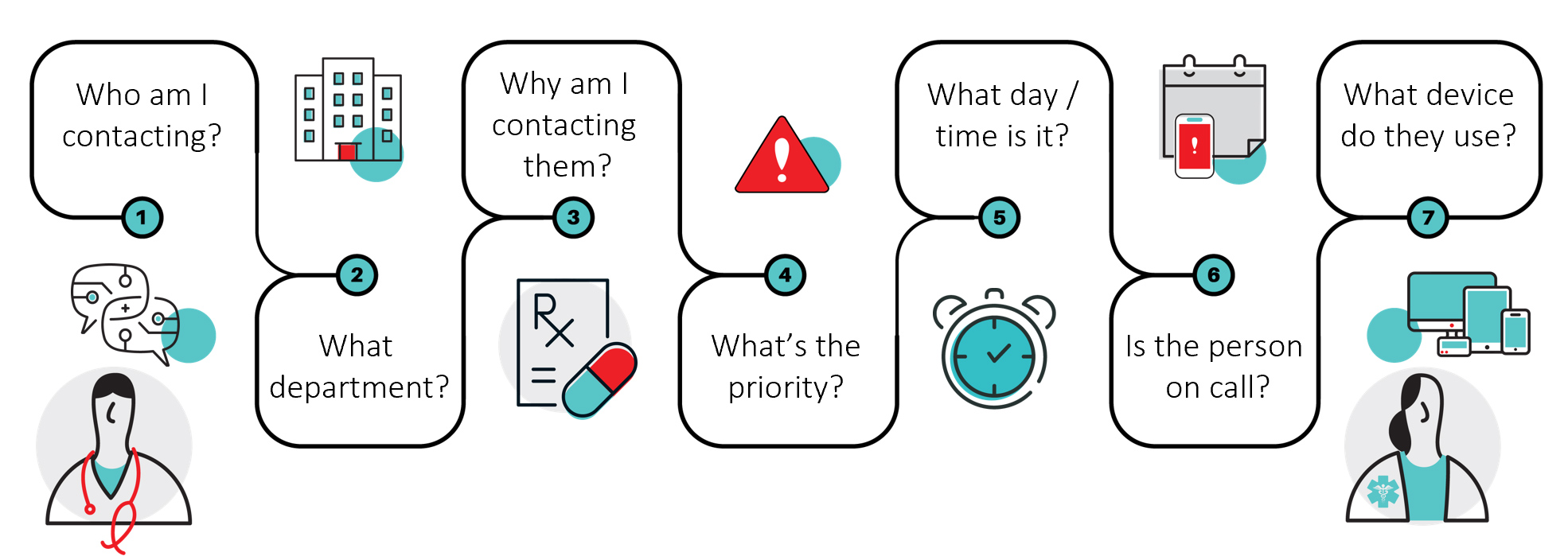Blog
Nurse perspective on secure messaging in healthcare: Why it’s key to clinical communication
When caring for patients, nurses follow a process that involves assessing the patient, providing a nursing diagnosis, and then planning, implementing, and evaluating the situation. The goal: improving the patient’s health and outcome. As nurses carry out these steps, they’re continually reprioritizing tasks, which involves ongoing multitasking across communication, information review, and documentation.
It’s a juggling act — caring for patients, relaying information to families and the care team, locating resources, and troubleshooting equipment. Communication needs to be simple and flexible, regardless of the patient’s acuity, where care team members are located, or staffing ratios. Communicating critical and even noncritical events during this juggling act should require little effort. THIS should be the easy part. But often, it’s not.
An example of navigating the care coordination challenge
Hannah is a typical med-surg nurse caring for four patients. One of them is a new admit, 68-year-old Todd, who has an acute kidney injury. Todd is struggling to breathe, and BiPAP isn’t really helping. He’s under tremendous stress, and his vital signs reflect his anxiety. Hannah is concerned with Todd’s respiratory status and consults with her charge nurse. They decide to call in the rapid response team. But this means Hannah must communicate the situation to staff who might be spread throughout the hospital. She might need to call the operator to page an on-call provider. And how will she communicate with dialysis to keep them in the loop and coordinate care?
If any of this communication takes place using a consumer texting app, Todd’s protected health information (PHI) is at risk. So not only does Hannah need to think about the complicated process of connecting with all the right team members, she and everyone else involved must also remember to protect Todd’s PHI. Unfortunately, this diminishes the quality of the information being shared, which could ultimately affect treatment.
Finding calm during chaos: A better way to communicate
Care teams often find themselves in this type of challenging and chaotic environment. In situations like these, secure, HIPAA-compliant messaging is critical. When used effectively, comprehensive secure messaging apps streamline workflows by integrating with directory information, clinical systems, the EHR, and on-call schedules. Effective messaging essentially powers the clinicians to spend more time with their patients and less time on the logistics.
When directory and on-call information are built right into the secure messaging app, a clinician can notify the rapid response team quickly and add other resources into the conversation seamlessly. Coordination can then happen across the full team without one person being solely responsible. In our scenario above, this means Hannah can focus more on Todd instead of wasting precious time trying to determine how to contact all the right people securely. Here’s how it works.
A look at the secure messaging process
With secure messaging, Hannah can search for “Rapid Response Team” in her app. Even though this group is dynamic — meaning its members change based on the day or shift — the app incorporates all the right people based on the integrated on-call schedule and directory information. This means Hannah can easily send a message to the right people, enabling coordination to begin at once. Hannah can also see who has read the message and reassure Todd that help is on the way.
As the care coordination and treatment plan unfolds, it’s possible for a member of the original group to add another resource to the conversation. In this case, Todd needs to be intubated, so the on-call anesthesiologist can be added simply by searching for the role. After the anesthesiologist has finished with the intubation, she can leave the chat.
Information such as the patient’s latest vitals can be relayed back and forth without any worry about violating HIPAA or sharing PHI. It’s secured and contained within the application. Best of all, with no disruptive overhead paging or added stress for the patient, the care team can do their jobs in complete synchronicity. It becomes quiet in the chaos.
Watch the on-demand webinar to learn more about this care coordination challenge >>
Are mobile communications secure?
In thinking about this patient scenario, what comes to mind about workflows in your organization? Is communication secure? Although most hospital guidelines generally prohibit the use of consumer messaging apps, recent Spok research found one in four staff report using a consumer app to reach another care team member during care coordination. In addition 82% of healthcare professionals are concerned that PHI is communicated via unsecure tools, and 59% say poor integration into clinical workflow is the biggest contributor to alarm fatigue and burnout.
Read the full 2020 healthcare communications report >>
Connecting clinical teams the right way
Spok Go® takes the guesswork out of what can otherwise be a lengthy communication decision-making process. It automatically incorporates each of the important decision factors to connect clinical teams with the people and information they need. Along the way, it reduces or even eliminates common roadblocks that hinder effectively coordinated care.

Protecting patient PHI, effectively coordinating care
The last thing anyone wants to do is violate HIPAA. But remember that your staff is busy caring for many sick patients, and one of those patients might be decompensating. In that chaotic moment, how should staff relay critical patient information? What app should they use? Spok Go solves the secure communication challenge and simplifies the process of coordinating care. Why not make it a goal for 2021 if it isn’t already?
To explore this topic further from the nursing point of view, watch this on-demand webinar.






